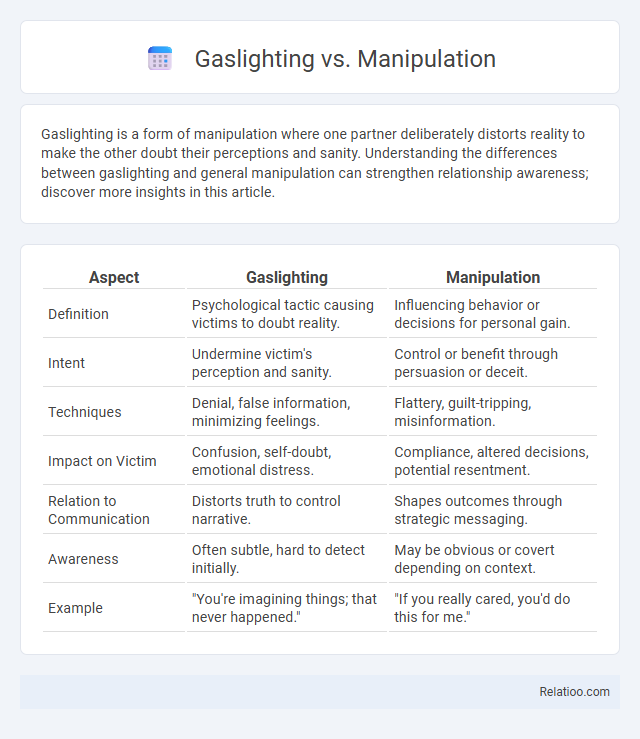Gaslighting is a form of manipulation where one partner deliberately distorts reality to make the other doubt their perceptions and sanity. Understanding the differences between gaslighting and general manipulation can strengthen relationship awareness; discover more insights in this article.
Table of Comparison
| Aspect | Gaslighting | Manipulation |
|---|---|---|
| Definition | Psychological tactic causing victims to doubt reality. | Influencing behavior or decisions for personal gain. |
| Intent | Undermine victim's perception and sanity. | Control or benefit through persuasion or deceit. |
| Techniques | Denial, false information, minimizing feelings. | Flattery, guilt-tripping, misinformation. |
| Impact on Victim | Confusion, self-doubt, emotional distress. | Compliance, altered decisions, potential resentment. |
| Relation to Communication | Distorts truth to control narrative. | Shapes outcomes through strategic messaging. |
| Awareness | Often subtle, hard to detect initially. | May be obvious or covert depending on context. |
| Example | "You're imagining things; that never happened." | "If you really cared, you'd do this for me." |
Understanding Gaslighting: Definition and Origins
Gaslighting is a form of psychological manipulation that causes you to doubt your own reality, memory, or perceptions, originating from the 1944 film "Gaslight" where a husband manipulates his wife to believe she's going insane. Unlike general manipulation, gaslighting specifically aims to destabilize and delegitimize a person's sense of truth and self-trust, often resulting in confusion, anxiety, and loss of confidence. Understanding the roots and mechanisms of gaslighting empowers you to recognize and resist its harmful effects in personal or professional relationships.
What Is Manipulation? Key Concepts Explained
Manipulation involves influencing or controlling someone's behavior or perceptions through deceptive, exploitative, or underhanded tactics to benefit the manipulator. Unlike gaslighting, which specifically aims to make you doubt your reality or sanity, manipulation can include a broad range of strategies such as guilt-tripping, persuasion, or withholding information. Understanding manipulation helps you recognize when your trust is being exploited and protect your emotional well-being.
Similarities Between Gaslighting and Manipulation
Gaslighting and manipulation both exploit psychological tactics to control and influence others, often undermining the victim's perception of reality and self-confidence. Both methods involve deceit, distortion of facts, and emotional exploitation to achieve dominance or compliance in relationships. The key similarity lies in their intentional use of confusion and mistrust to weaken the victim's ability to assert autonomy and truth.
Key Differences: Gaslighting vs Manipulation
Gaslighting involves systematically making You doubt your reality and memory, creating confusion and a loss of self-trust, while manipulation broadly refers to influencing or controlling someone's behavior or decisions often through deceptive or exploitative tactics. The key difference lies in gaslighting's specific intent to distort perception and erode mental stability, whereas manipulation may not always target perception but instead aims to gain advantage or compliance. Recognizing these distinctions is crucial for identifying harmful interpersonal dynamics and protecting Your mental well-being.
Psychological Impact on Victims
Gaslighting inflicts deep psychological trauma by causing victims to doubt their perception of reality, leading to confusion, anxiety, and loss of self-trust. Manipulation subtly shifts a victim's decisions and emotions, eroding confidence and fostering dependency without overt distortion of reality. Understanding these distinctions helps protect Your mental health and promote recovery from emotional abuse.
Signs and Symptoms to Watch For
Signs and symptoms of gaslighting include persistent doubt about your memories, feeling disoriented, and questioning your perception of reality due to deliberate misinformation. Manipulation often involves subtle tactics like guilt-tripping, lying, or exploiting your vulnerabilities to control your decisions or behavior. Recognizing these patterns early empowers you to set boundaries and protect your mental well-being.
Gaslighting in Relationships: Real-Life Examples
Gaslighting in relationships involves deliberate psychological manipulation where one partner systematically undermines the other's perception of reality, leading to confusion and self-doubt. Real-life examples include denying past events, twisting facts, and dismissing the victim's feelings to gain control and power. This form of emotional abuse differs from general manipulation by its targeted intent to distort the victim's sense of truth and memory.
Manipulation Tactics in Everyday Life
Manipulation tactics in everyday life often involve subtle psychological strategies such as guilt-tripping, misinformation, and emotional exploitation to influence Your decisions and behavior without Your awareness. Unlike gaslighting, which specifically aims to distort Your perception of reality, general manipulation can include a broader range of deceptive or coercive actions aimed at control and compliance. Recognizing these tactics is crucial for maintaining personal boundaries and preserving mental well-being amidst interpersonal dynamics.
How to Protect Yourself from Gaslighting and Manipulation
Recognizing the differences between gaslighting, manipulation, and other forms of emotional abuse is crucial for protecting your mental health. Gaslighting involves distorting your reality to make you doubt your perceptions, while manipulation subtly influences your decisions and feelings to serve someone else's agenda. To safeguard yourself, trust your instincts, set firm boundaries, and seek support from trusted friends or professionals to maintain clarity and confidence in your experiences.
Seeking Help and Recovery Strategies
Recognizing gaslighting, manipulation, and narcissistic abuse requires understanding their psychological impact and seeking professional help from therapists specializing in trauma and abusive dynamics. Recovery strategies include establishing strong support networks, practicing self-validation techniques, and engaging in cognitive behavioral therapy to rebuild self-esteem and cognitive clarity. Consistent boundaries and education on healthy relationships are crucial steps toward healing and preventing future abuse.

Infographic: Gaslighting vs Manipulation
 relatioo.com
relatioo.com